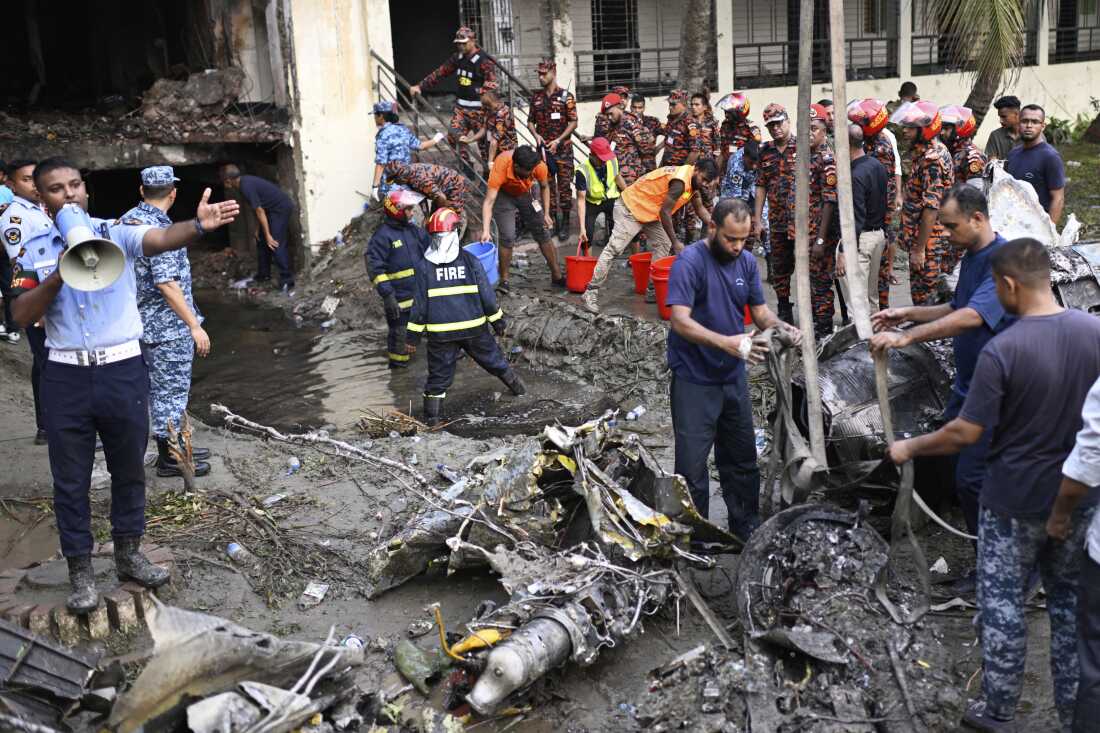A tragic aviation accident in Bangladesh has resulted in the deaths of at least 19 people after a military aircraft crashed into a school building in a densely populated area. The incident has sent shockwaves throughout the country and raised serious concerns about the safety of conducting military flight operations near civilian infrastructure.
The crash occurred during what officials have described as a routine training exercise by the Bangladesh Air Force. The aircraft, a fighter jet used for aerial drills and pilot training, encountered technical difficulties shortly after takeoff. Despite apparent efforts by the pilot to navigate away from populated zones, the jet lost altitude and ultimately collided with a school compound that was in operation at the time.
Witnesses from the neighborhood reported hearing a loud explosion followed by a column of smoke rising above the crash site. Within moments, flames engulfed parts of the school and surrounding structures. Emergency services, including firefighters, police, and medical personnel, arrived quickly, but the intensity of the fire and scattered debris complicated rescue efforts. Several students, teachers, and bystanders were among those killed, while many others sustained injuries and were rushed to nearby hospitals.
Officials have stated that the number of victims could increase as rescuers keep combing through the wrecked structures. A minimum of twelve people are receiving treatment for serious burns, broken bones, and injuries related to trauma. The status of some is still critical.
The current condition of the pilot remains unverified by officials; however, sources imply there was a last-ditch effort to evacuate from the plane. Investigators are examining the aircraft’s flight data and black box to reconstruct the events that resulted in the accident. Preliminary conclusions point to a mechanical malfunction, but a comprehensive investigation has been initiated to ascertain the underlying cause and pinpoint any safety procedure oversights.
In a statement, military officials expressed their condolences to the victims’ families and pledged full cooperation with civilian authorities conducting the investigation. They emphasized that the flight was part of a scheduled training routine, adhering to all existing operational guidelines. However, this assertion has done little to ease the anger and grief felt by the local community.
El suceso ha provocado una vez más el debate sobre la cercanía de las operaciones militares a las zonas civiles pobladas. A medida que las ciudades de Bangladesh siguen creciendo, las líneas divisorias entre las bases aéreas y las áreas residenciales o educativas se han vuelto menos definidas. Grupos de la sociedad civil, líderes locales y defensores de la educación están ahora pidiendo una revisión de las rutas de vuelo militares y una implementación más estricta de las medidas de seguridad.
Residents of the affected area described the crash as a horrific event that unfolded in seconds. Many recalled seeing children fleeing from classrooms, parents arriving in panic, and rescue workers braving heat and smoke to reach those trapped inside the rubble. Survivors spoke of shattered windows, collapsing walls, and chaotic scenes as students tried to escape through corridors choked with dust and flames.
Schools in the region have temporarily suspended classes in mourning, and government officials have announced compensation for the families of those who lost their lives. Psychological support services are also being made available to help students and staff cope with the trauma.
In Dhaka, the country’s leaders observed a period of silence in parliament, committing to reassess the nation’s aviation safety regulations. The Ministry of Defense, alongside the Civil Aviation Authority, is conducting a comprehensive evaluation of the risks associated with military flight activities, especially those close to educational institutions, medical facilities, and living districts.
The tragedy has also drawn international attention, with neighboring countries and global organizations extending condolences and offering assistance. Human rights groups have urged Bangladeshi authorities to prioritize transparency in the investigation and take urgent steps to prevent similar accidents in the future.
Experts in aviation safety stress that while aircraft malfunctions are not always preventable, minimizing their impact through better planning and risk management is possible. They point to international best practices that restrict low-altitude military flights in high-density areas and emphasize the importance of routine maintenance, pilot training, and updated emergency response protocols.
Bangladesh, like many nations, faces the challenge of balancing national defense priorities with civilian safety. As its military modernizes and expands training operations, ensuring that those efforts do not endanger nearby populations will be critical. Calls for the relocation of training areas, tighter oversight, and better coordination between military and civil authorities are growing louder in the wake of this tragedy.
The individuals in the community impacted by the accident are also calling for responsibility and ongoing assistance. In addition to the direct physical harm, the psychological impact of the event will probably leave a lasting impression. For the families who lost relatives and the youngsters who observed the tragedy, the path to recovery will be extensive.
As the nation grieves, the focus now turns to action—ensuring that this loss of life leads to meaningful change. Whether through policy reform, enhanced safety standards, or more thoughtful urban planning, the goal must be to prevent such devastating accidents from recurring. The crash has underscored the urgent need for a reassessment of how military and civilian interests intersect, especially in a rapidly urbanizing country.
The coming weeks will be critical as investigators analyze evidence, authorities outline policy responses, and communities begin to recover. For Bangladesh, the tragic loss of life is a painful reminder of the importance of vigilance, preparedness, and a commitment to protecting every citizen—especially the most vulnerable.
